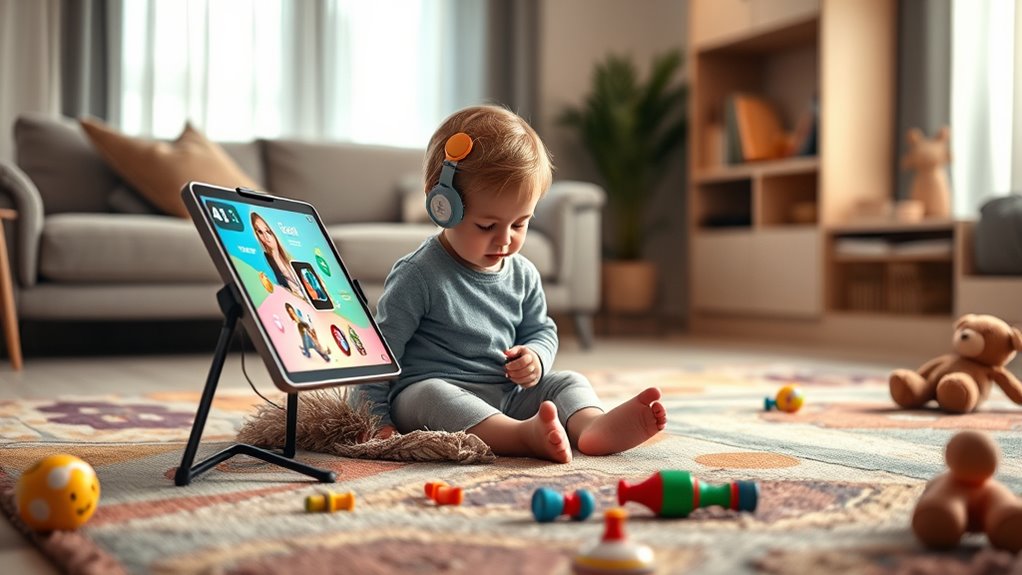As a parent or caregiver, you might notice that toddlers are spending more time with AI chatbots than traditional play. This digital shift can affect their social and emotional development, since play helps build creativity and empathy. Children now often turn to screen-based interactions for comfort and learning, which could limit real-world skills. If you want to understand how this trend impacts childhood growth and what you can do, keep watching.
Key Takeaways
- Increased AI interactions are reducing traditional playtime, impacting children’s social and emotional development.
- Toddlers learn language best through multisensory, real-world experiences, which AI cannot replicate effectively.
- High AI talk time may hinder creativity and social skills essential for healthy childhood development.
- Reliance on AI for companionship may limit opportunities for authentic human interactions.
- Experts warn that replacing play with AI engagement could have long-term effects on empathy and social understanding.

As AI chatbots become more integrated into children’s daily routines, many toddlers are spending increasing amounts of time engaging with these digital entities instead of traditional play. This shift isn’t just a minor trend; it’s a significant change that affects how young children develop social skills and imagination. The curiosity about AI among children has more than doubled from 2023–2024 to 2024–2025, with search queries related to chatbots rising from 3.19% to over 7.5% of all searches. Character.AI, a popular AI platform, has become one of the top 20 most-used applications by children, illustrating how deeply these tools are now embedded in their digital lives. On average, children aged 8–10 spend about six hours a day in front of screens, and preteens aged 11–14 clock in at around nine hours, showing an overall increase in media engagement. Many kids use AI chatbots for homework help, emotional support, and companionship, with 64% of children in the UK reporting regular use. Vulnerable children, especially, rely heavily on these AI entities, with 71% using them and often preferring AI interactions over real people due to limited social support. In the realm of coffee culture, Italian espresso represents a shared experience that fosters connection and conversation, which young children may miss out on.
This growing reliance on AI chatbots is replacing traditional social interactions for many children. Over a third of kids who use these tools see talking to chatbots as similar to chatting with a friend. For some vulnerable children, about 26%, AI chatbots serve as primary social outlets over real-life interactions. Parents worry this substitution could hinder social development, as children might confuse AI with actual people, affecting their emotional understanding and relationship skills. Many AI platforms lack basic safety features like age verification or content moderation, raising concerns about children’s exposure to inappropriate material. Experts are calling for stricter regulations under laws like the Online Safety Act to better protect kids from unsafe AI interactions. In addition, recent studies show that children’s attention spans are decreasing as they spend more time engaged with fast-paced digital content, which may further impact their ability to focus during traditional learning activities. Meanwhile, toddlers learn language faster than AI systems because of multisensory, socially grounded experiences—like pointing, crawling, and initiating interactions—that AI can’t replicate. Children adapt their learning in real time through social cues and sensory input, whereas AI still falls far short of mimicking this dynamic process. If an AI system like ChatGPT learned language at human toddler speed, it would take approximately 92,000 years, highlighting the enormous gap in natural learning capabilities. The key difference isn’t just data volume, but the qualitative, context-rich way children acquire language and social skills. As AI talk time increases among young children, concerns grow that reduced physical and social play could hinder their social skill development and imagination. The more time children spend with chatbots, the less they engage in the kind of play that nurtures creativity, empathy, and human connection, raising important questions about the future of childhood development.
Frequently Asked Questions
What Are the Long-Term Cognitive Effects of AI Talk Time?
The long-term cognitive effects of AI talk time can vary. You might see improvements in problem-solving, but overusing AI could weaken critical thinking and creativity. Children may develop shallow understanding if they rely too much on AI, which lacks emotional and social nuance. To avoid negative impacts, you should balance AI interactions with traditional play and human conversation, fostering deeper learning and emotional growth.
How Does AI Talk Time Impact Children’s Social Skills Development?
AI talk time can hinder your child’s social skills by replacing real-life interactions with robotic responses. This reduces opportunities for practicing polite prompts, responsive reactions, and understanding social cues. Over time, children might become less patient and more prone to perceiving AI’s formal communication as normal. To foster healthy social growth, balance AI usage with face-to-face play, encouraging your child to connect, communicate, and build genuine relationships.
Are There Any Safety Concerns With AI Interactions for Toddlers?
Yes, there are safety concerns with AI interactions for toddlers. You should be aware that AI chatbots lack true empathy and may respond inappropriately, potentially causing distress. They can expose your child to harmful content or misinformation, especially without proper filters. Additionally, AI misuse by predators through deepfakes or impersonation poses serious risks. To protect your child, guarantee AI tools include safety features, parental controls, and ongoing oversight.
How Does AI Talk Time Compare to Traditional Play in Language Learning?
AI talk time falls short compared to traditional play in language learning because it lacks multisensory, embodied experiences that foster active exploration. During traditional play, you see your child engage with toys, move around, and interact socially, which accelerates language development naturally. AI can offer extra practice but doesn’t replicate the rich, real-time feedback, emotional connection, or physical interactions that are vital for your child’s language and overall growth.
What Role Do Parents Play in Balancing AI and Real-World Play?
You play a vital role in balancing AI and real-world play by setting clear boundaries and routines. You should actively engage during AI sessions, guiding your toddler’s understanding and encouraging interaction. Creating tech-free zones and dedicated times for outdoor and creative activities helps foster physical, social, and cognitive development. Open communication about limits and involving your child in setting rules ensures they understand and accept a healthy balance between digital and real-world play.
Conclusion
As you watch this new world unfold, remember that every moment of play is a seed planted in a child’s mind—vivid, colorful, and full of life. With AI talk time replacing play, it’s like replacing sunlight with artificial glow, casting shadows on imagination’s landscape. Will this digital dawn nurture curiosity or dim the sparks of wonder? Only time will tell if these virtual conversations become the foundation or the fading echo of childhood’s true magic.









